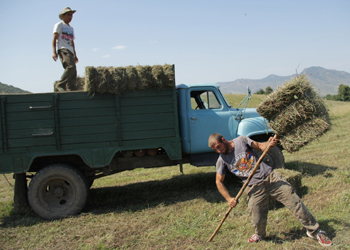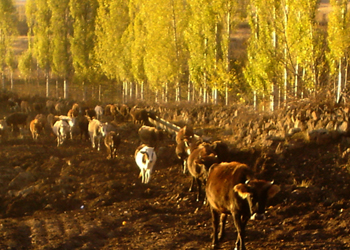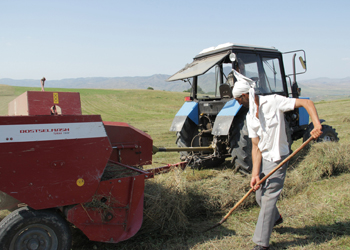Story by Sergey Meloyan | CARMAC Project Coordinator | Heifer Armenia
Photos courtesy of Heifer Armenia Staff
 After Armenia gained independence in 1991, and agriculture was privatized and decentralized, around 340,000 farms formed with an average size of 3.5 acres each.
After Armenia gained independence in 1991, and agriculture was privatized and decentralized, around 340,000 farms formed with an average size of 3.5 acres each.
These small, fragmented farms still exist, although, taking into account current developments in the market, they are not able to function effectively due to a closed mindset on the part of the farmers, working separately from each other, a general lack of the necessary agricultural equipment and an absence of infrastructure.
The Community Agricultural Resource Management and Competitiveness project launched in 2011 to target these issues. The overarching goal is to achieve efficient economies of scale through a gradual change in agricultural resource management practices and attitudes of people in rural areas. The project aims at improving existing pasture management practices, improving the pasture infrastructure, strengthening the agricultural advisory services, creating agricultural cooperatives and providing these cooperatives with the necessary agricultural equipment, training and practical skills. The project adopted these strategies for the development of the mountainous regions of Armenia. Heifer Armenia, which has been working in the rural areas of Armenia since 1999, has agreed to support and assist the cooperatives in reaching the project goals.
 A year has passed since the start of the project, and pasture-users’ unions have been formed in 54 out of 55 communities participating in the project. In 33 of those unions, around 82 units of agricultural equipment have been installed. Tractors, plows, cultivators and balers give co-op members the opportunity to work together and combine their efforts for a common purpose. This approach will change the mindset of farmers in post-Soviet countries, like Armenia, who believe that working alone is better than combining efforts.
A year has passed since the start of the project, and pasture-users’ unions have been formed in 54 out of 55 communities participating in the project. In 33 of those unions, around 82 units of agricultural equipment have been installed. Tractors, plows, cultivators and balers give co-op members the opportunity to work together and combine their efforts for a common purpose. This approach will change the mindset of farmers in post-Soviet countries, like Armenia, who believe that working alone is better than combining efforts.
The services offered by the pasture-user co-ops are 20 to 30 percent cheaper, compared to neighboring communities without these co-ops. As a result, the prices for hay and other feed for animals have substantially decreased in these co-op communities. The trainings organized covering Heifer’s working principles and values, cooperative development, pasture management, accounting and other topics have been successful in building the capacity of project participants and enabling them to put the acquired knowledge into practice.
 Particularly notable is Heifer’s Methodology of Passing on the Gift® (POG), which has been implemented in this project, as well. In the framework of the project, co-op members will collect a certain portion of the co-op’s income in order to purchase additional equipment for their co-op or others, either in their village or in neighboring villages. As a result, more families will have access to the cheaper services provided by the co-ops. This makes the co-op use the equipment more efficiently, and thus the perception of members becomes more agricultural small-business oriented versus just subsistence farming. With the help of services provided in the co-ops, about 33 percent of the annual POG amount has already been collected during the last few months.
Particularly notable is Heifer’s Methodology of Passing on the Gift® (POG), which has been implemented in this project, as well. In the framework of the project, co-op members will collect a certain portion of the co-op’s income in order to purchase additional equipment for their co-op or others, either in their village or in neighboring villages. As a result, more families will have access to the cheaper services provided by the co-ops. This makes the co-op use the equipment more efficiently, and thus the perception of members becomes more agricultural small-business oriented versus just subsistence farming. With the help of services provided in the co-ops, about 33 percent of the annual POG amount has already been collected during the last few months.
In addition to this, a substantive amount of agricultural equipment is going to be procured and delivered during the winter months, which will ensure a full range of agricultural services for the next agricultural season in the spring. The first agricultural season has finished, and the results are already tangible, although the process of placing equipment is still ongoing. The initial results of the project indicate that after the completion of equipment placement, the results of the second agricultural season are going to be far more impressive.
Learn how you can be a part of the exciting changes in Armenia through Heifer International.